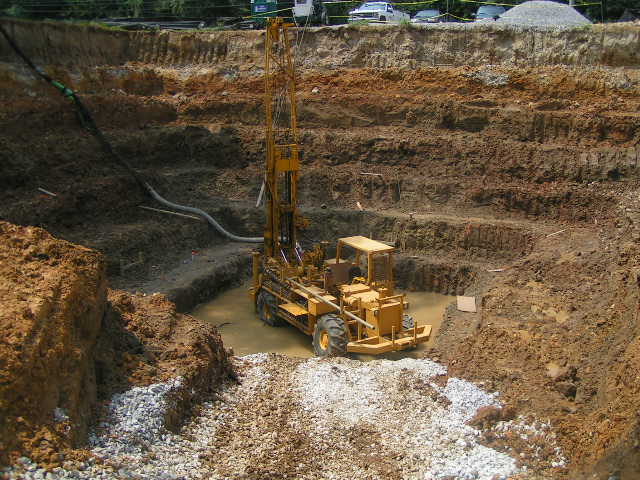Comprehensive Geotechnical Works to Guarantee Site Stability
Comprehensive Geotechnical Works to Guarantee Site Stability
Blog Article
Just How Consulting Engineers Enhance Geotechnical Engineering Projects: Insights Into Their Knowledge, Methodologies, and Collaborative Approaches
Consulting engineers are crucial in enhancing geotechnical engineering tasks, using their specialized knowledge to browse the intricacies of subsurface problems. Their collaborative techniques foster interaction amongst diverse job stakeholders, inevitably shaping the job's trajectory.
Function of Consulting Engineers
The knowledge of consulting engineers in geotechnical engineering is fundamental to the effective execution of construction tasks. These specialists play a critical duty in assessing dirt and rock homes, which are essential factors influencing design and building decisions. By carrying out complete site investigations, seeking advice from designers gather necessary information that educates the layout procedure, making sure tasks are constructed on secure and ideal ground.
Consulting designers additionally supply very useful understandings right into danger administration (geotechnical geologist). They determine prospective geotechnical risks, such as landslides, soil liquefaction, and negotiation concerns, allowing stakeholders to carry out efficient mitigation strategies. Their knowledge aids in optimizing structure layouts, which can cause considerable cost savings and boosted safety and security
Moreover, seeking advice from engineers offer as a crucial link in between job owners, engineers, and service providers. Their ability to equate complex geotechnical information into workable suggestions cultivates partnership and promotes notified decision-making throughout the project lifecycle. This multidisciplinary technique not just enhances job performance but additionally ensures compliance with regulative standards and finest techniques.
Key Methods in Geotechnical Design

One key methodology is site investigation, which entails carrying out field tests and lab analyses to gather information on subsurface conditions. Methods such as Criterion Infiltration Screening (SPT) and Cone Infiltration Screening (CPT) are extensively made use of to review dirt stratigraphy and toughness. Furthermore, geophysical techniques, including seismic and electrical resistivity surveys, offer non-invasive ways to evaluate subsurface attributes.
One more important technique is numerical modeling, which enables designers to mimic various situations and predict how soil-structure communications will certainly act under various loading problems. Limited Element Evaluation (FEA) is a common method employed in this context.
Moreover, the design of structures, maintaining frameworks, and earthworks relies greatly on these techniques - geotechnical geologist. By incorporating advanced logical devices with area data, speaking with engineers can create customized services that address particular task challenges, ultimately contributing to the security and security of construction projects
Value of Dirt Analysis
Soil evaluation offers as a fundamental element in geotechnical design, providing crucial insights right into the physical and chemical buildings of you can look here soil essential for effective construction planning. Recognizing soil attributes is vital for identifying its load-bearing ability, water drainage actions, and possibility for negotiation or instability. Detailed dirt examinations, including sampling and laboratory screening, assistance recognize parameters such as dirt kind, dampness content, thickness, and shear strength.
These evaluations educate the option of ideal building strategies and materials, inevitably influencing project safety and long life. For instance, natural soils may call for various foundation designs compared to granular soils, necessitating customized engineering services. Dirt evaluation aids in identifying contaminants that could pose threats to human wellness or the setting, permitting for the advancement of mitigation strategies.
Including dirt analysis right into the very early phases of task advancement aids to lessen unexpected difficulties, guaranteeing that engineers can prepare for and attend to prospective issues prior to they escalate. By developing an extensive understanding of the site problems, speaking with engineers can enhance layout performance and minimize expenses, therefore improving the overall success of geotechnical design projects.
Collaborative Approaches in Tasks
Successful geotechnical projects often hinge on joint review techniques that bring together varied proficiency from numerous self-controls. Reliable partnership amongst seeking advice from engineers, rock hounds, ecological scientists, and building and construction experts is crucial for attending to complex difficulties and optimizing task end results. By leveraging the distinct skills and knowledge of each employee, jobs can profit from a holistic understanding of the site conditions, regulative needs, and engineering restraints.
Regular communication and interdisciplinary meetings assist in the sharing of understandings and foster a society of synergy. These collaborative initiatives enable the identification of prospective threats early in the project lifecycle, enabling prompt reduction techniques. Moreover, integrating feedback from stakeholders, consisting of local areas and governing firms, makes certain that all viewpoints are thought about, improving job approval and conformity.
Furthermore, the combination of sophisticated modern technologies, such as Geographic Info Systems (GIS) and Structure Info Modeling (BIM), additional improves partnership. These tools enable for the real-time sharing of data and visualization of geotechnical conditions, advertising notified decision-making. Eventually, a collaborative strategy not just enhances job execution however also lays the structure for ingenious options to complex geotechnical design obstacles.
Effect On Task End Results

Consulting engineers use advanced methodologies such as risk evaluation and predictive modeling, which enhance the accuracy of project projections. Their capacity to click to read more integrate innovative modern technologies, like geotechnical instrumentation and information analytics, further improves the layout and construction processes. Therefore, tasks experience enhanced performance, minimized costs, and decreased delays.
Moreover, cultivating effective interaction and partnership amongst employee boosts analytic capacities. When obstacles occur, an unified front permits speedy recognition of solutions, preventing possible obstacles. Eventually, the joint initiatives of speaking with engineers add to better end results, making certain that tasks meet both regulatory standards and client assumptions.
Verdict

Report this page